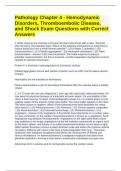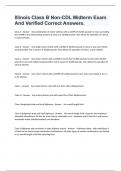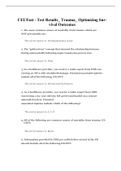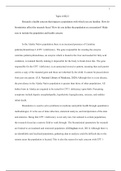Pathology Chapter 4 - Hemodynamic
Disorders, Thromboembolic Disease,
and Shock Exam Questions with Correct
Answers
1. While shaving one morning, a 23-year-old man nicks his lip with a razor. Seconds
after the injury, the bleeding stops. Which of the following mechanisms is most likely to
reduce blood loss from a small dermal arteriole? □ (A) Protein C activation □ (B)
Vasoconstriction □ (C) Platelet aggregation □ (D) Neutrophil chemotaxis □ (E) Fibrin
polymerization - Answer-1 (B) Vasoconstriction :The initial response to injury is
arteriolar vasoconstriction, but this is transient, and the coagulation mechanism must be
initiated to maintain hemostasis.
Protein C is involved in anticoagulation to counteract clotting.
Platelet aggregation occurs with release of factors such as ADP, but this takes several
minutes.
Neutrophils are not essential to hemostasis.
Fibrin polymerization is part of secondary hemostasis after the vascular injury is initially
closed.
1. 2 A 73-year-old man was diagnosed 1 year ago with pancreatic adenocarcinoma. He
now sees his physician because of a transient ischemic attack. On auscultation of the
chest, a heart murmur is heard. Echocardiography shows a 1-cm nodular lesion on the
superior aspect of the anterior mitral valve leaflet. The valve leaflet appears to be intact.
The blood culture is negative. Which of the following terms best describes this mitral
valve lesion? □ (A) Adenocarcinoma □ (B) Atheroma □ (C) Chronic passive congestion
□ (D) Mural thrombus □ (E) Petechial hemorrhage □ (F) Phlebothrombosis □ (G)
Vegetation - Answer-2 (G) Vegetation: A thrombotic mass that forms on a cardiac valve
(or, less commonly, on the cardiac mural endocardium) is known as a vegetation. Such
vegetations may produce thromboemboli. Vegetations on the right-sided heart valves
may embolize to the lungs; vegetations on the left embolize systemically to organs such
as the brain, spleen, and kidney. A so-called paradoxical embolus occurs when a right-
sided cardiac thrombus crosses a patent foramen ovale and enters the systemic arterial
circulation. Patients with cancer may have a hypercoagulable state (e.g., Trousseau
syndrome, with malignant neoplasms) that favors the development of arterial and
venous thromboses. An adenocarcinoma is a malignant neoplasm that arises from
glandular epithelium, forming a mass lesion; endocardial metastases are quite rare.
Atheromas form in arteries and do not typically involve the cardiac valves.
,Chronic passive congestion refers to capillary, sinusoidal, or venous stasis of blood
within an organ such as the lungs or liver.
Mural thrombi are thrombi that form on the surfaces of the heart or large arteries. The
term typically is reserved for large thrombi in a cardiac chamber or dilated aorta or large
aortic branch; it is not used to describe thrombotic lesions on cardiac valves.
A petechial hemorrhage is a grossly pinpoint hemorrhage.
Phlebothrombosis occurs when stasis in large veins promotes thrombosis formation.
1. 3 A 21-year-old woman sustains multiple injuries, including fractures of the right
femur and tibia and the left humerus, in a motor vehicle collision. She is admitted to the
hospital, and the fractures are stabilized surgically. Soon after admission to the hospital,
she is in stable condition. She suddenly becomes severely dyspneic, however, 2 days
later. Which of the following complications is the most likely cause of this sudden
respiratory difficulty? □ (A) Right hemothorax □ (B) Pulmonary edema □ (C) Fat
embolism □ (D) Cardiac tamponade □ (E) Pulmonary infarction - Answer-3 (C) Fat
embolism : The mechanism for fat embolism is unknown, in particular, why onset of
symptoms is delayed 1 to 3 days after the initial injury (or 1 week for cerebral
symptoms). The cumulative effect of many small fat globules filling peripheral
pulmonary arteries is the same as one large pulmonary thromboembolus.
Hemothorax and cardiac tamponade would be immediate complications after traumatic
injury, not delayed events.
Pulmonary edema severe enough to cause dyspnea would be unlikely to occur in
hospitalized patients because fluid status is closely monitored.
Pulmonary infarction may cause dyspnea, but pulmonary thromboembolus from deep
venous thrombosis is typically a complication of a longer hospitalization.
1. 4 For the past week, a 61-year-old man has had increasing levels of serum AST and
ALT. On physical examination, he has lower leg swelling with grade 2+ pitting edema to
the knees and prominent jugular venous distention to the level of the mandible. Based
on the gross appearance of the liver, seen in the figure, which of the following
underlying conditions is most likely to be present? □ (A) Thrombocytopenia □ (B) Portal
vein thrombosis □ (C) Chronic renal failure □ (D) Common bile duct obstruction □ (E)
Congestive heart failure - Answer-4 (E) Congestive heart failure : The figure shows a
so-called nutmeg liver caused by chronic passive congestion. The elevated enzyme
levels suggest that the process is so severe that hepatic centrilobular necrosis also has
occurred. The physical findings suggest right-sided heart failure.
The regular pattern of red lobular discoloration seen in the figure is unlikely to occur in
hemorrhage from thrombocytopenia, characterized by petechiae and ecchymoses.
A portal vein thrombus would diminish blood flow to the liver, but it would not be likely to
cause necrosis because of that organ's dual blood supply.
Hepatic congestion is not directly related to renal failure, and hepatorenal syndrome has
no characteristic gross appearance.
,Biliary tract obstruction would produce bile stasis (cholestasis) with icterus. (***technical
term for jaundice.***)
1. A 55-year-old woman has had discomfort and swelling of the left leg for the past
week. On physical examination, the leg is slightly difficult to move, but on palpation,
there is no pain. A venogram shows thrombosis of deep left leg veins. Which of the
following mechanisms is most likely to cause this condition? □ (A) Turbulent blood flow
□ (B) Nitric oxide release □ (C) Ingestion of aspirin □ (D) Hypercalcemia □ (E)
Immobilization - Answer-5 (E) Immobilization: The most important and the most
common cause of venous thrombosis is vascular stasis, which often occurs with
immobilization.
Turbulent blood flow may promote thrombosis, but this risk factor is more common in
fast-flowing arterial circulation.
Nitric oxide is a vasodilator and an inhibitor of platelet aggregation.
Aspirin inhibits platelet function and limits thrombosis.
Calcium is a cofactor in the coagulation pathway, but an increase in calcium has
minimal effect on the coagulation process.
A 25-year-old woman who has had altered consciousness and slurred speech for the
past 24 hours is brought to the emergency department. A head CT scan shows a right
temporal hemorrhagic infarction. Cerebral angiography shows a distal right middle
cerebral arterial occlusion. Within the past 3 years, she has had an episode of
pulmonary embolism. A pregnancy 18 months ago ended in miscarriage. Laboratory
studies show a false-positive serologic test for syphilis, normal prothrombin time,
elevated partial thromboplastin time, and normal platelet count. Which of the following is
the most likely cause of these findings? □ (A) Disseminated intravascular coagulation □
(B) Factor V mutation □ (C) Hypercholesterolemia □ (D) Lupus anticoagulant □ (E) Von
Willebrand disease - Answer-6 (D) Lupus anticoagulant: These findings are
characteristic of a hypercoagulable state. The patient has antibodies that react with
cardiolipin, a phospholipid antigen used for the serologic diagnosis of syphilis. These
so-called antiphospholipid antibodies are directed against phospholipid-protein
complexes and are sometimes called lupus anticoagulant because they are present in
some patients with systemic lupus erythematosus (SLE). Lupus anticoagulant may
occur in individuals with no evidence of SLE, however. Patients with lupus anticoagulant
have recurrent arterial and venous thrombosis and repeated miscarriages. In vitro,
these antibodies inhibit coagulation by interfering with the assembly of phospholipid
complexes. In vivo, the antibodies induce a hypercoagulable state by unknown
mechanisms.
Disseminated intravascular coagulation is an acute consumptive coagulopathy
characterized by elevated prothrombin time and partial thromboplastin time, and
decreased platelet count.
The prothrombin time and partial thromboplastin time are normal in patients with factor
V (Leiden) mutation.
, Hypercholesterolemia promotes atherosclerosis over many years, and the risk of arterial
thrombosis increases.
Von Willebrand's disease affects platelet adhesion and leads to a bleeding tendency,
not to thrombosis.
7. 7 A 66-year-old woman comes to the emergency department 30 minutes after the
onset of chest pain that radiates to her neck and left arm. She is diaphoretic and
hypotensive; the serum troponin I level is elevated. Thrombolytic therapy is begun.
Which of the following drugs is most likely to be administered? □ (A) Tissue
plasminogen activator □ (B) Aspirin □ (C) Heparin □ (D) Nitric oxide □ (E) Vitamin K -
Answer-7 (A) Tissue plasminogen activator is a thrombolytic agent that causes the
generation of plasmin, which cleaves fibrin to dissolve clots.
Aspirin prevents formation of new thrombi by inhibiting platelet aggregation.
Heparin prevents thrombosis by activating antithrombin III.
Nitric oxide is a vasodilator.
Vitamin K is required for synthesis of certain clotting factors.
1. 8 A 49-year-old man is in stable condition after an infarction of the anterior left
ventricular wall. He receives therapy with anti-arrhythmic and pressor agents. He
develops severe breathlessness 3 days later, and an echocardiogram shows a
markedly decreased ejection fraction. He dies 2 hours later. At autopsy, which of the
following microscopic changes is most likely to be present in the lungs? □ (A)
Congestion of alveolar capillaries with fibrin and neutrophils in alveoli □ (B) Congestion
of alveolar capillaries with transudate in alveoli □ (C) Fibrosis of alveolar walls with
hemosiderin-laden macrophages in alveoli □ (D) Multiple areas of subpleural
hemorrhagic necrosis □ (E) Purulent exudate in the pleural space □ (F) Purulent
exudate in the mainstem bronchi - Answer-8 (B) ) Congestion of alveolar capillaries with
transudate in alveoli : Acute left ventricular failure after a myocardial infarction causes
venous congestion in the pulmonary capillary bed and increased hydrostatic pressure,
which leads to pulmonary edema by transudation in the alveolar space.
Neutrophils and fibrin would be found in cases of acute inflammation of the lung (i.e.,
pneumonia).
Fibrosis and hemosiderin-filled macrophages (heart failure cells) would be found in
long-standing, not acute, left ventricular failure.
Subpleural hemorrhagic necrosis occurs if there are pulmonary thromboemboli. These
thromboemboli can cause right-sided heart failure.
Purulent exudate in the pleural space (empyema) or draining from bronchi results from
bacterial infection, not heart failure.







